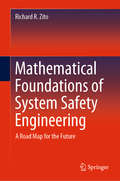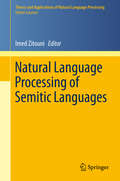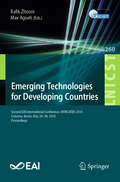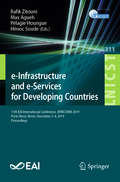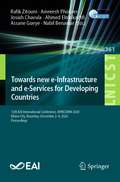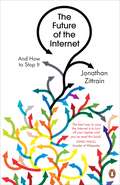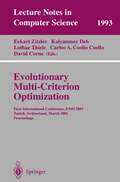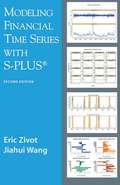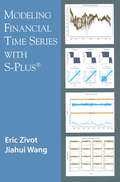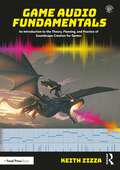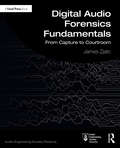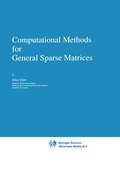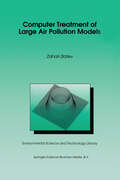- Table View
- List View
Advances in Service-Oriented and Cloud Computing: International Workshops of ESOCC 2022, Wittenberg, Germany, March 22–24, 2022, Revised Selected Papers (Communications in Computer and Information Science #1617)
by Christian Zirpins Guadalupe Ortiz Zoltan Nochta Oliver Waldhorst Jacopo Soldani Massimo Villari Damian TamburriThis volume contains the technical papers presented in the workshops, which took place at the 9th European Conference on Service-Oriented and Cloud Computing, ESOCC 2022, held in Wittenberg, Germany, in March 2022.The 4 full papers and 7 short papers included in these proceedings were carefully reviewed and selected from 17 submissions. The workshop proceedings volume of ESOCC 2022 contains contributions from the following workshops and events:First International Workshop on AI for Web Application Infrastructure and Cloud Platform Security (AWACS 2022)PhD Symposium of ESOCC 2022ESOCC 2022 Projects TrackESOCC 2022 Industrial Track
Advances in Service-Oriented and Cloud Computing: International Workshops of ESOCC 2020, Heraklion, Crete, Greece, September 28–30, 2020, Revised Selected Papers (Communications in Computer and Information Science #1360)
by Christian Zirpins Iraklis Paraskakis Vasilios Andrikopoulos Nane Kratzke Claus Pahl Nabil El Ioini Andreas S. Andreou George Feuerlicht Winfried Lamersdorf Guadalupe Ortiz Willem-Jan Van den Heuvel Jacopo Soldani Massimo Villari Giuliano Casale Pierluigi PlebaniThis volume contains the technical papers presented in the workshops, PhD Symposium and EU Projects Track which took place at the 8th European Conference on Service-Oriented and Cloud Computing, ESOCC 2020, held in Heraklion, Crete, Greece, in September 2020: 1st International Workshop on Edge Adoption and Migration, EdgeWays 2020, 16th International Workshop on Engineering Service-Oriented Applications and Cloud Services, WESOACS 2020, ESOCC 2020 PhD Symposium, ESOCC 2020 EU Projects Track. Due to the COVID-19 pandemic the conference and workshops were held in a virtual format. The 17 full papers and 2 short papers were reviewed and selected from 22 submissions. The papers focus on specific topics in service-oriented and cloud computing domains such as limits and/or advantages of existing cloud solutions, future internet technologies, efficient and adaptive deployment and management of service-based applications across multiple clouds, novel cloud service migration practices and solutions, digitization of enterprises in the cloud computing era, federated cloud networking services.
Mathematical Foundations of System Safety Engineering: A Road Map for the Future
by Richard R. ZitoThis graduate-level textbook elucidates low-risk and fail-safe systems in mathematical detail. It addresses, in particular, problems where mission-critical performance is paramount, such as in aircraft, missiles, nuclear reactors and weapons, submarines, and many other types of systems where “failure” can result in overwhelming loss of life and property. The book is divided into four parts: Fundamentals, Electronics, Software, and Dangerous Goods. The first part on Fundamentals addresses general concepts of system safety engineering that are applicable to any type of system. The second part, Electronics, addresses the detection and correction of electronic hazards. In particular, the Bent Pin Problem, Sneak Circuit Problem, and related electrical problems are discussed with mathematical precision. The third part on Software addresses predicting software failure rates as well as detecting and correcting deep software logical flaws (called defects). The fourth part on Dangerous Goods presents solutions to three typical industrial chemical problems faced by the system safety engineer during the design, storage, and disposal phases of a dangerous goods’ life cycle.
Natural Language Processing of Semitic Languages (Theory and Applications of Natural Language Processing)
by Imed ZitouniResearch in Natural Language Processing (NLP) has rapidly advanced in recent years, resulting in exciting algorithms for sophisticated processing of text and speech in various languages. Much of this work focuses on English; in this book we address another group of interesting and challenging languages for NLP research: the Semitic languages. The Semitic group of languages includes Arabic (206 million native speakers), Amharic (27 million), Hebrew (7 million), Tigrinya (6.7 million), Syriac (1 million) and Maltese (419 thousand). Semitic languages exhibit unique morphological processes, challenging syntactic constructions and various other phenomena that are less prevalent in other natural languages. These challenges call for unique solutions, many of which are described in this book.The 13 chapters presented in this book bring together leading scientists from several universities and research institutes worldwide. While this book devotes some attention to cutting-edge algorithms and techniques, its primary purpose is a thorough explication of best practices in the field. Furthermore, every chapter describes how the techniques discussed apply to Semitic languages. The book covers both statistical approaches to NLP, which are dominant across various applications nowadays and the more traditional, rule-based approaches, that were proven useful for several other application domains. We hope that this book will provide a "one-stop-shop'' for all the requisite background and practical advice when building NLP applications for Semitic languages.
Emerging Technologies for Developing Countries: First International Eai Conference, Africatek 2017, Marrakech, Morocco, March 27-28, 2017 Proceedings (Lecture Notes of the Institute for Computer Sciences, Social Informatics and Telecommunications Engineering #206)
by Rafik Zitouni Max AguehThis book constitutes the refereed proceedings of the Second International EAI Conference on Emerging Technologies for Developing Countries, AFRICATEK 2018, held in Cotonou, Benin, in May 2018. The 12 revised full papers and 4 short papers were selected from 27 submissions. The papers are organized thematically in tracks, starting with ITS and security, applications and IT services, gaming and user experience.
e-Infrastructure and e-Services for Developing Countries: 11th EAI International Conference, AFRICOMM 2019, Porto-Novo, Benin, December 3–4, 2019, Proceedings (Lecture Notes of the Institute for Computer Sciences, Social Informatics and Telecommunications Engineering #311)
by Rafik Zitouni Max Agueh Pélagie Houngue Hénoc SoudeThis book constitutes the thoroughly refereed proceedings of the 11th International Conference on e-Infrastructure and e-Services for Developing Countries, AFRICOMM 2019, held in Porto-Novo, Benin, in December 2019. The 19 full papers were carefully selected from 46 submissions. The accepted papers provide a wide range of research topics including targeted infrastructures, Internet of Things (IoT), wireless and mobile networks, intelligent transportation systems (ITS), software and network security, cloud and virtualization, data analytics, and machine learning.
Towards new e-Infrastructure and e-Services for Developing Countries: 12th EAI International Conference, AFRICOMM 2020, Ebène City, Mauritius, December 2-4, 2020, Proceedings (Lecture Notes of the Institute for Computer Sciences, Social Informatics and Telecommunications Engineering #361)
by Rafik Zitouni Amreesh Phokeer Josiah Chavula Ahmed Elmokashfi Assane Gueye Nabil BenamarThis book constitutes the thoroughly refereed proceedings of the 12th International Conference on e-Infrastructure and e-Services for Developing Countries, AFRICOMM 2020, held in Ebène City, Mauritius, in December 2020. Due to COVID-19 pandemic the conference was held virtually. The 20 full papers were carefully selected from 90 submissions. The papers are organized in four thematic sections on dynamic spectrum access and mesh networks; wireless sensing and 5G networks; software-defined networking; Internet of Things; e-services and big data; DNS resilience and performance.
Kommunikation in Verteilten Systemen: GI/ITG-Fachtagung Braunschweig, 19.–21. Februar 1997 (Informatik aktuell)
by Martina ZitterbartThe Future of the Internet: And How to Stop It
by Jonathan ZittrainIn The Future of the Internet: And How to Stop It Jonathan Zittrain explores the dangers the internet faces if it fails to balance ever more tightly controlled technologies with the flow of innovation that has generated so much progress in the field of technology. Zittrain argues that today's technological market is dominated by two contrasting business models: the generative and the non-generative. The generative models - the PCs, Windows and Macs of this world - allow third parties to build upon and share through them. The non-generative model is more restricted; appliances such as the xbox, iPod and tomtom might work well, but the only entity that can change the way they operate is the vendor.If we want the internet to survive we need to change. People must wake up to the risk or we could lose everything.
Basiswissen Informatik: Grundideen einfach und anschaulich erklärt
by Eckart ZitzlerDieses reich bebilderte Sachbuch bietet Ihnen einen einfachen, aber fundierten Einstieg in das Gebiet der Informatik und erklärt Schritt für Schritt, wie Computer und Internet funktionieren. In 18 Kapiteln werden die Schlüsselbegriffe, die der Computertechnologie zugrunde liegen, in überschaubaren Portionen erläutert. Dabei wird bewusst auf technische Details, Formeln und komplizierte Definitionen verzichtet, der Fokus liegt auf dem Verstehen der Ideen. Es geht um digital und analog, die innere Funktionsweise und den Aufbau von Computern, um Codierung, Programmiersprachen, Algorithmen und Datenstrukturen, um die Prinzipien und die Nutzung des Internets sowie um Künstliche Intelligenz, Verschlüsselung und Sicherheit. Das Buch ist in drei Teile untergliedert und führt vom Einsteigen über das Vertiefen zum Durchdringen. Es richtet sich an alle, die ein Basiswissen in Informatik erwerben und hinter die Kulissen der digitalen Welt schauen wollen. Damit die Computerwissenschaft kein Buch mit sieben Siegeln bleibt. Die vorliegende 2. Auflage ist ergänzt um einen Ausblick zu den Themen Deep Learning, Quantum Computing, Blockchain sowie Virtual/Augmented Reality.
Basiswissen Informatik - Grundideen einfach und anschaulich erklärt
by Eckart ZitzlerDieses reich bebilderte Sachbuch bietet Ihnen einen einfachen, aber fundierten Einstieg in das Gebiet der Informatik und erklärt Schritt für Schritt, wie Computer und Internet funktionieren. In 18 Kapiteln werden die Schlüsselbegriffe, die der Computertechnologie zugrunde liegen, in überschaubaren Portionen erläutert. Dabei wird bewusst auf technische Details, Formeln und komplizierte Definitionen verzichtet, der Fokus liegt auf dem Verstehen der Ideen. Es geht um digital und analog, die innere Funktionsweise und den Aufbau von Computern, um Codierung, Programmiersprachen, Algorithmen und Datenstrukturen, um die Prinzipien und die Nutzung des Internets sowie um Künstliche Intelligenz, Verschlüsselung und Sicherheit. Das Buch ist in drei Teile untergliedert und führt vom Einsteigen über das Vertiefen zum Durchdringen. Es richtet sich an alle, die ein Basiswissen in Informatik erwerben und hinter die Kulissen der digitalen Welt schauen wollen. Damit die Computerwissenschaft kein Buch mit sieben Siegeln bleibt.
Dem Computer ins Hirn geschaut: Informatik entdecken, verstehen und querdenken
by Eckart ZitzlerDieses Buch entführt Sie hinter die Kulissen der Informatik, macht die ihr zugrunde liegenden Ideen verständlich und lässt Sie verblüffende Parallelen zum Lebendigen entdecken. Schritt für Schritt tauchen Sie ein in die Welt des Computers und lernen,wie sich mit Strom rechnen lässt, wie Computer aufgebaut sind und mit der Außenwelt kommunizieren,welche ausgeklügelten Methoden es gibt, um Informationen festzuhalten, wie aus einem Netz von Computern ein Weltcomputer wird, wie Informationen geschickt codiert und chiffriert werden können, wo Computer an ihre Grenzen stoßen undwie Informatik und Biologie zusammengedacht werden können, um Einsichten über die Welt zu gewinnen. Zahlreiche Beispiele aus der Lebenswelt reichern die Darstellung an und zeigen auf, wie nah automatisierte und natürliche Informationsverarbeitung beieinander liegen. Wenn Sie also eine lebendige, interdisziplinär ausgerichtete und reichhaltig illustrierte Einführung in die Informatik suchen und gerne über den Tellerrand hinausschauen, wird dieses Buch eine Fundgrube für Sie sein.
Evolutionary Multi-Criterion Optimization: First International Conference, EMO 2001, Zurich, Switzerland, March 7-9, 2001 Proceedings (Lecture Notes in Computer Science #1993)
by Eckart Zitzler Kalyanmoy Deb Lothar Thiele Carlos Coello Coello David CorneThis book constitutes the refereed proceedings of the First International Conference on Multi-Criterion Optimization, EMO 2001, held in Zurich, Switzerland in March 2001.The 45 revised full papers presented were carefully reviewed and selected from a total of 87 submissions. Also included are two tutorial surveys and two invited papers. The book is organized in topical sections on algorithm improvements, performance assessment and comparison, constraint handling and problem decomposition, uncertainty and noise, hybrid and alternative methods, scheduling, and applications of multi-objective optimization in a variety of fields.
String Processing and Information Retrieval: 14th International Symposium, SPIRE 2007 Santiago, Chile, October 29-31, 2007 Proceedings (Lecture Notes in Computer Science #4726)
by Nivio Ziviani Ricardo Baeza-YatesThis book constitutes the refereed proceedings of the 14th International Symposium on String Processing and Information Retrieval, SPIRE 2007. Coverage in the 27 revised full papers includes dictionary algorithms, text searching, pattern matching, text compression, text mining, natural language processing, sequence driven protein structure prediction, XML, SGML, information retrieval from semi-structured data, text mining and generation of structured data from text.
IoT Platforms, Use Cases, Privacy, and Business Models: With Hands-on Examples Based on the VICINITY Platform
by Carna Zivkovic Yajuan Guan Christoph GrimmThis book provides a comprehensive and consistent introduction to the Internet of Things. Hot topics, including the European privacy legislation GDPR, and homomorphic encryption are explained. For each topic, the reader gets a theoretical introduction and an overview, backed by programming examples. For demonstration, the authors use the IoT platform VICINITY, which is open-source, free, and offers leading standards for privacy. Presents readers with a coherent single-source introduction into the IoT;Introduces selected, hot-topics of IoT, including GDPR (European legislation on data protection), and homomorphic encryption;Provides coding examples for most topics that allow the reader to kick-start his own IoT applications, smart services, etc.
Modeling Financial Time Series with S-PLUS®
by Eric Zivot Jiahui WangThis book represents an integration of theory, methods, and examples using the S-PLUS statistical modeling language and the S+FinMetrics module to facilitate the practice of financial econometrics. It is the first book to show the power of S-PLUS for the analysis of time series data. It is written for researchers and practitioners in the finance industry, academic researchers in economics and finance, and advanced MBA and graduate students in economics and finance. Readers are assumed to have a basic knowledge of S-PLUS and a solid grounding in basic statistics and time series concepts. This edition covers S+FinMetrics 2.0 and includes new chapters.
Linear Algebra in Data Science (Compact Textbooks in Mathematics)
by Peter Zizler Roberta La HayeThis textbook explores applications of linear algebra in data science at an introductory level, showing readers how the two are deeply connected. The authors accomplish this by offering exercises that escalate in complexity, many of which incorporate MATLAB. Practice projects appear as well for students to better understand the real-world applications of the material covered in a standard linear algebra course. Some topics covered include singular value decomposition, convolution, frequency filtering, and neural networks. Linear Algebra in Data Science is suitable as a supplement to a standard linear algebra course.
Game Audio Fundamentals: An Introduction to the Theory, Planning, and Practice of Soundscape Creation for Games
by Keith ZizzaGame Audio Fundamentals takes the reader on a journey through game audio design: from analog and digital audio basics to the art and execution of sound effects, soundtracks, and voice production, as well as learning how to make sense of a truly effective soundscape. Presuming no pre-existing knowledge, this accessible guide is accompanied by online resources – including practical examples and incremental DAW exercises – and presents the theory and practice of game audio in detail, and in a format anyone can understand. This is essential reading for any aspiring game audio designer, as well as students and professionals from a range of backgrounds, including music, audio engineering, and game design.
Game Audio Fundamentals: An Introduction to the Theory, Planning, and Practice of Soundscape Creation for Games
by Keith ZizzaGame Audio Fundamentals takes the reader on a journey through game audio design: from analog and digital audio basics to the art and execution of sound effects, soundtracks, and voice production, as well as learning how to make sense of a truly effective soundscape. Presuming no pre-existing knowledge, this accessible guide is accompanied by online resources – including practical examples and incremental DAW exercises – and presents the theory and practice of game audio in detail, and in a format anyone can understand. This is essential reading for any aspiring game audio designer, as well as students and professionals from a range of backgrounds, including music, audio engineering, and game design.
Low-Power High-Resolution Analog to Digital Converters: Design, Test and Calibration (Analog Circuits and Signal Processing)
by Amir Zjajo José Pineda de GyvezWith the fast advancement of CMOS fabrication technology, more and more signal-processing functions are implemented in the digital domain for a lower cost, lower power consumption, higher yield, and higher re-configurability. This has recently generated a great demand for low-power, low-voltage A/D converters that can be realized in a mainstream deep-submicron CMOS technology. However, the discrepancies between lithography wavelengths and circuit feature sizes are increasing. Lower power supply voltages significantly reduce noise margins and increase variations in process, device and design parameters. Consequently, it is steadily more difficult to control the fabrication process precisely enough to maintain uniformity. The inherent randomness of materials used in fabrication at nanoscopic scales means that performance will be increasingly variable, not only from die-to-die but also within each individual die. Parametric variability will be compounded by degradation in nanoscale integrated circuits resulting in instability of parameters over time, eventually leading to the development of faults. Process variation cannot be solved by improving manufacturing tolerances; variability must be reduced by new device technology or managed by design in order for scaling to continue. Similarly, within-die performance variation also imposes new challenges for test methods.In an attempt to address these issues, Low-Power High-Resolution Analog-to-Digital Converters specifically focus on: i) improving the power efficiency for the high-speed, and low spurious spectral A/D conversion performance by exploring the potential of low-voltage analog design and calibration techniques, respectively, and ii) development of circuit techniques and algorithms to enhance testing and debugging potential to detect errors dynamically, to isolate and confine faults, and to recover errors continuously. The feasibility of the described methods has been verified by measurements from the silicon prototypes fabricated in standard 180nm, 90nm and 65nm CMOS technology.
Digital Audio Forensics Fundamentals: From Capture to Courtroom (Audio Engineering Society Presents)
by James ZjalicDigital Audio Forensics Fundamentals offers an accessible introduction to both the theory and practical skills behind this emerging field of forensic science. Beginning with an overview of the history of the discipline, the reader is guided through forensic principles and key audio concepts, before being introduced to practical areas such as audio enhancement, audio authentication, and the presentation of reports. Covering all aspects of audio forensics from the capture to the courtroom, this book is pivotal reading for beginners entering the field, as well as experienced professionals looking to develop their knowledge of the practice.
Digital Audio Forensics Fundamentals: From Capture to Courtroom (Audio Engineering Society Presents)
by James ZjalicDigital Audio Forensics Fundamentals offers an accessible introduction to both the theory and practical skills behind this emerging field of forensic science. Beginning with an overview of the history of the discipline, the reader is guided through forensic principles and key audio concepts, before being introduced to practical areas such as audio enhancement, audio authentication, and the presentation of reports. Covering all aspects of audio forensics from the capture to the courtroom, this book is pivotal reading for beginners entering the field, as well as experienced professionals looking to develop their knowledge of the practice.
Computational Methods for General Sparse Matrices (Mathematics and Its Applications #65)
by Zahari ZlatevComputer Treatment of Large Air Pollution Models (Environmental Science and Technology Library #2)
by Zahari Zlatev"Models are often the only way of interpreting measurements to in vestigate long-range transport, and this is the reason for the emphasis on them in many research programs". B. E. A. Fisher: "A review of the processes and models of long-range transport of air pollutants", Atmospheric Environment, 17(1983), p. 1865. Mathematical models are (potentially, at least) powerful means in the efforts to study transboundary transport of air pollutants, source-receptor relationships and efficient ways of reducing the air pollution to acceptable levels. A mathematical model is a complicated matter, the development of which is based on the use of (i) various mechanisms describing mathematically the physical and chemical properties of the studied phenomena, (ii) different mathematical tools (first and foremost, partial differenti al equations), (iii) various numerical methods, (iv) computers (especially, high-speed computers), (v) statistical approaches, (vi) fast and efficient visualization and animation techniques, (vii) fast methods for manipulation with huge sets of data (input data, intermediate data and output data).


